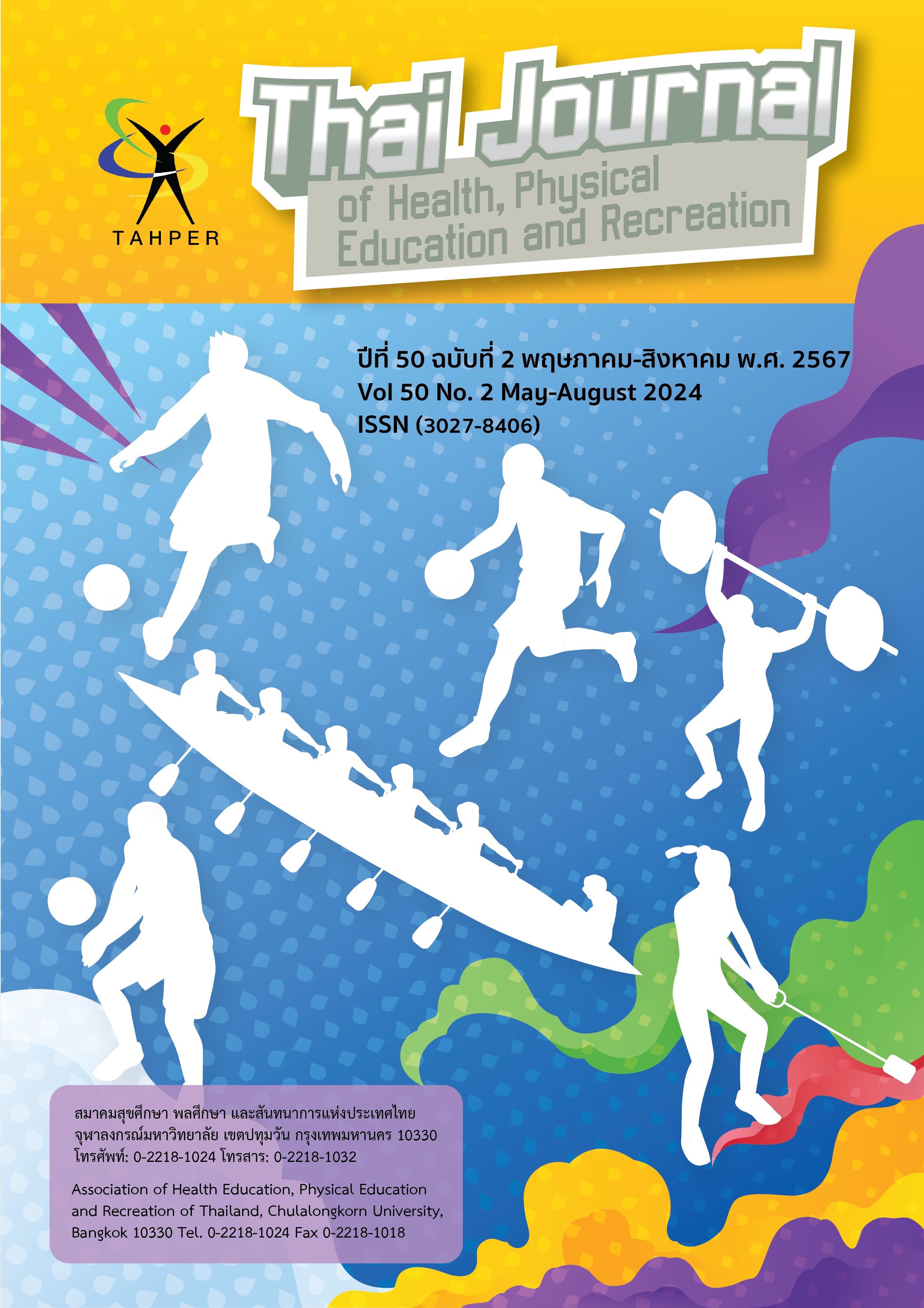Relationship between Fast Feet Test and Soccer-Specific Speed Test in Young Soccer Players
Main Article Content
Abstract
The purpose of this research was to studies the relationship between fast feet test and soccer-specific speed test in young players. 135 male youth soccer players aged 13-18 years old, who were football player at Nakhonnon wittaya 6 school, Bangkok sports Scholl and Nakhonpathom Municipaloty sports Scholl. All subject were assessed fast feet test and soccer-specific speed test including straight sprinting speed test, change of direction speed test and speed with the ball test. Data were analyzed by using Pearson product moment correlation coefficient to analyzed the relationship between, fast feet test, and soccer-specific speed test and One-way ANOVA to compare between competitive age level and positional role of players. An alpha level of .05 was used on all statistical tests.
The result showed that fast feet test was correlated (p<.05) with straight sprinting speed test, change of direction speed test and speed with the ball test (r = -0.84, -0.75 and -0.72) respectively. fast feet test and soccer-specific speed test were significance (P<0.05) difference between competitive age level (U14, U16 and U18) and fast feet test were also significance (P<0.05) difference between positional role of players (defender, midfielder and attacker) but there were no significant difference (P>0.05) between positional role pf players with soccer-specific speed test. It could be concluded that the fast feet test be able to measure the quickness performance for young soccer players. It can be correlate with straight sprinting speed , change of direction speed and speed with the ball and also discriminated between different competitive aged level and positional role.
Article Details

This work is licensed under a Creative Commons Attribution-NonCommercial-NoDerivatives 4.0 International License.
Critical thinking in journals is the right of the author. The Association of Health Education, Physical Education and Recreation of Thailand is not always required, to create diversity in ideas and creativity.
ความคิด ข้อวิพากษ์ในวารสารเป้นสิทธิของผู้เขียน สมาคมสุขศึกษา พลศึกษา และสันทนาการแห่งประเทศไทยไม่จำเป็นต้องเห็นชอบด้วยเสมอไป เพื่อให้เกิดความหลากหลายในความคิดและความสร้างสรรค์
References
นิรอมลี มะกาเจ เพ็ญนิภา พูลสวัสดิ์ สุพัชริน เขมรัตน์ และอภิลักษณ์ เทียนทอง. (2559). ลักษณะสัดส่วนและองค์ประกอบร่างกายในนักกีฬาฟุตซอลระดับเยาวชนไทย:การศึกษาเชิงเปรียบเทียบระหว่างระดับอายุและระดับผลสำเร็จของการแข่งขัน วารสารคณะพลศึกษา, 19(1), 218-232.
สุพัชริน เขมรัตน์ และนิรอมลี มะกาเจ. 2558. รายงานการวิจัยเรื่อง “ลักษณะของขนาดสัดส่วนร่างกาย องค์ประกอบของร่างกายและสมรรถภาพทางกลไก ของนักกีฬาฟุตซอลระดับเยาวชนไทย”กลุ่มวิจัยและพัฒนาสำนักวิทยาศาสตร์การกีฬา กรมพลศึกษา กระทรวงการท่องเที่ยวและกีฬา.
Bompa T. and M Carrera. (2015). Conditioning young athletes. Human kinetic. Champaign, United state.
Di Salvo, V., R. Baron, H., Tschan, F. J., Montero, N., Bachi and F. , & Pigozzi. (2007). Performance characteristics according to playing position in elite soccer. International Journal of Sports Medicine, 28, 222-227.
Fitness Technology. (2002). Kinematic System Measurement User’s Guide. Available http://www.innervations.com/downloads/KMS%20User%20Guide%20Version%202001.
Graham J. Assessment of Speed. (2013). In Jeffreys. Developing Speed (Sports performance series) National Strength and Conditioning Association. Human Kinetic Publishers., United State.
Greg G. (2009). Completed Conditioning for Soccer. Human Kinetic. Champiang, USA.
Jovanovic M., Sporis G., Omrcen D., Fiorentini F. (2011). Effects of speed, agility, quickness training method on power performance in elite soccer players. The Journal of Strength and Conditioning Research, 25(5), 1285-1292.
Mackenzie B. (2005). 101 Performance Evaluation Tests. Jonathan Pye., London. England.
Pearson, A. (2001). Speed, Agility and Quickness for Soccer. London: A & C Black.
Reilly T. (2003). Motion Analysis and Physological Demands. 59-72.In Reilly, T and M. Williams.eds. Science and Soccer. 2nd ed. Routledge . UK.
Rhodri S. Lloyd and Jon L. Oliver. (2019). Strength and Conditioning for Young Athletes: Science and Application. 2nd edition. Routledge.
Sheppard, J. M. amd W. B. Young. (2006). Agility literature review: Classifications, training and testing. Journal of Sports Sciences, 24(9),919 -932.
Spaniol, F., Flores, J., Bonnette, R., Melrose, D., & Ocker, L. (2010). The relationship between speed and agility of professional arena league football players. Journal of Strength and Conditioning Research, 24(Supplement).
Sisodiya A. S. and Y. Monica. (2010). Relationship of anthropometric variables to basketball playing ability. Journal of Advances in Developmental Research, 1(2), 191-194.
Sporis G., Milanovic Z., Trajkovic N., & Joksimovic A. (2011). Correlation between speed, agility and quickness (SAQ) in elite young soccer player. Acta kinesiologica, 5(2), 36-41.
Yap C. W., College B. C., Brown L. E., & Woodman G. (2009). Development of speed,agility and quickness for the female soccer athlete. Strength and Conditioning Journal, 22(1), 9-12.
Young, & Farrow, D. (2006). A review of agility: practical application for strength and conditioning. Strength and Conditioning Journal, 28(5), 24-29.


